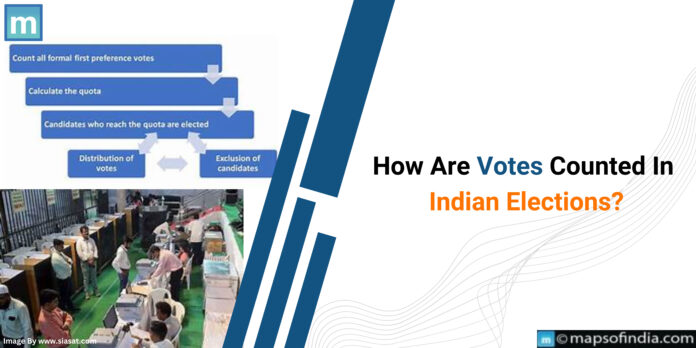India declared the results of the 2024 general elections on June 4.
The Indian Election Commission predetermines the timing of the count. The Returning Officer (RO) for a Parliamentary Constituency oversees the election process and counting the votes. The RO designates the site and assigns counting centres based on the total number of votes. The RO is typically a local authority or an officer of the government and is nominated by the ECI after consulting with the State Government. Common locations include government schools, colleges, or the RO’s office in that constituency.
Each constituency’s Assistant Returning Officers (ARO) assist the RO. One table is used for counting postal ballots, while another is used for EVM counting, which the ARO oversees. Agents in charge of counting supervise the process. According to the ECI, each table must have a micro-observer, a counting assistant, and a counting supervisor. Counting tables are positioned behind wire mesh or barricades to prevent the Agents from physically approaching the EVMs, allowing them to see and examine the procedure.
In the second round of randomisation, officers receive information about their designated centres. A final agent drawing takes place on the day of the main count. Part of the training process is thoroughly examining the Special Tag, Green Paper Seals, and important seals attached to the carrying case and the EVM Control Unit to ensure the safeguards are in place and haven’t been tampered with.
The procedure of counting
The counting hall has 14 parallel-arranged tables. The first seven tables are used for counting assembly votes in simultaneous parliamentary and assembly elections, whereas the remaining tables are used for counting parliamentary votes.
At 8 in the morning, vote counting started under the RO’s close supervision. Enumerating postal ballots is the first step in the counting process, according to ECI’s “Handbook for Counting Agents.” “The EVM counting can start and continue, irrespective of the stage of postal ballot counting,” following a half-hour.
Votes are registered on the Electronic Voting machine (EVM) control Units (CU), which are transported from polling places to the counting hall and arranged among the counting tables. Additionally, the vote totals listed on form 17C, which displays the total number of ballots cast at each polling place, are supplied. The “Result” and “Print” buttons are located in the centre of the CU. The Green Paper Seal is behind the Result button. When the seal is broken, and the button is pressed, the votes cast for each candidate and NOTA should appear immediately.
Counting is conducted in rounds, and after each round, the results from 14 EVMs are announced and reported as “leads” in the media. According to ECI, the Control Units for the subsequent round must not be placed on the counting tables until the preceding round’s counting is complete. If more than one round is required, it can continue.
When the EVM counting is finished, the VVPAT slips are tallied. The voter can see the party’s name, symbol, and serial number on the Voter Verifiable Paper Audit Trails for approximately seven seconds. It can be utilised to support the outcomes of the EVM and is thereafter saved in the device. Within the counting hall, the verification is carried out in a secure VVPAT Counting Booth (any counting table can be transformed into a Booth once EVM counting is complete).
Before, only VVPAT slips from a single EVM in each Assembly sector or seat were subject to physical verification per ECI guideline 16.6. Later, the Supreme Court mandated that the number of EVMs used for verification be increased to five in each Assembly segment of a Parliamentary Constituency, or approximately 25–50 machines per PC. Following the VVPAT matching procedure, the RO may announce the final constituency result if it is coherent and clear.
The counting procedure is carried out under strict security and monitoring. Throughout the counting period, no electronic devices are permitted inside the hallways, including calculators, laptops, tablet computers, and telephones.
What occurs if there are discrepancies?
According to Rule 56(D) (4)(b) of the Conduct of Elections Rules, 1961, if there is a difference in the number of votes cast on CUs and on paper slips, the ECI orders that the printed paper slips be counted. The outcome of this count is considered the final decision. If there is a disagreement in the count of one of the five VVPATs, it is unclear what additional action the ECI would take.
The RO may receive a letter from a candidate, their election agent, or any of the counting agents outlining the reasons for recounting the votes cast at any or all polling places. This year, activists, members of civil society, and opposition parties have voiced doubts about ECI’s commitment to holding free and fair elections and its transparency. Concerns over the potential for manipulation during the counting stage have increased due to the ECI’s tardiness in uploading voter turnout statistics broken down by polling station and disparities between the final voter percentage and the initial turnout figures.
Rajya Sabha MP Kapil Sibal released a checklist for political parties and candidates to adhere to on counting day on May 26 to promote alertness. He instructed the parties to note the machine’s opening time and to compare the CU’s serial number before and after hitting the “Result” button. The total number of votes cast must also match the number listed in Form 17C Part I.




